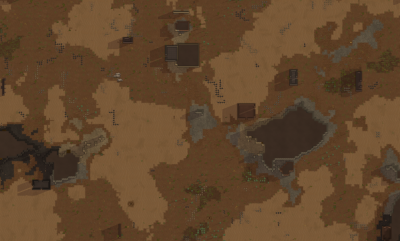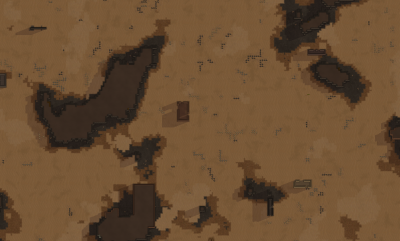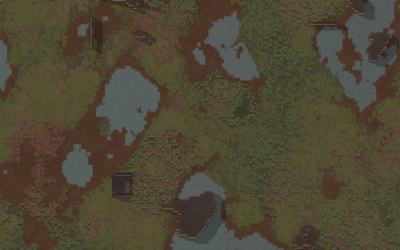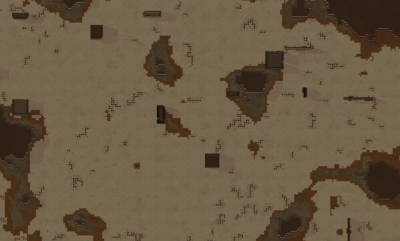Biomes
|
Biomes are types of area on a planet, characterized by their terrain properties, climate, flora and fauna, diseases and special challenges. Each world tile has one particular biome.
There are ten biome types in RimWorld, divided into three categories: Moderate, Arid and Cold.
The following diagram is a simple chart of biomes by intensity, and therefore you could view this to see which biome could best suit your experience or playstyle:
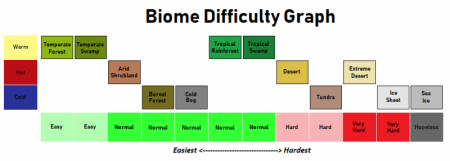
Moderate Biomes
These biomes are rich in flora and fauna, and also have a slightly elevated rate of disease. They generally have year-round growing periods, or longer growing periods at the very least.
Ocean
A vast body of water, inhabited by all sorts of marine life and plants. As there are no solid places on which you can land, oceans are unplayable biomes.
Season, Temperature and Plant Growth Cycle
- Season: Varies significantly: anywhere from year-round to never
- Temperature: Annual average of around 30 °C (86 °F) in the equator, down to around -30 °C (-22 °F) in the extreme north or south. Steadily decreases the closer to the poles you go.
- Plant Growth Cycle: Marine plants thrive in their own ways underwater - but this we shall never know for definite.
Lake
A smaller body of water. Unplayable because there is nowhere to land on.
Season, Temperature and Plant Growth Cycle
- Season: Varies significantly: anywhere from year-round to never
- Temperature: Annual average of around 30 °C (86 °F) in the equator, down to around -30 °C (-22 °F) in the extreme north or south. Steadily decreases the closer to the poles you go.
- Plant Growth Cycle: Aquatic plants thrive in their own ways underwater - but this we shall never know for definite.
Temperate forest
A friendly biome dominated by forests of deciduous trees interspersed with fertile clearings. Many species of animals move around in the trees and on the plains.
Season, Temperature and Plant Growth Cycle
- Season: Varies considerably, can be year-round or just 11th of Spring - 1st of Fall.
- Temperature: An annual average of just above 0 °C (32 °F) is possible, up to an average of 20 °C (68 °F) in warmer climates.
- Plant Growth Cycle: Depending on location, plant growth may slow during autumn and stop during winter.
Tropical rainforest
A thick, moist jungle. Dense overgrowth and aggressive wildlife make construction and survival difficult. Tropical Rainforests are also notorious for sweltering summers and diabolical diseases, including Sleeping Sickness: a slow-progressing, long-lasting disease that is exclusive to the tropics.
Season, Temperature and Plant Growth Cycle
- Season: Year-round.
- Temperature: Averages 20 °C (68 °F) to 30 °C (86 °F) over the course of the whole year. Heat waves generally push temperatures up to the 50 °C (122 °F) - 60 °C (140 °F) range.
- Plant Growth Cycle: Plants thrive throughout the year. Heat waves can slow plant growth though.
Temperate Swamp
Temperate swamps have lots of plants. Marshy soil on this map will impose great building restrictions.
Most habitable of the swamp biomes, but is nevertheless still challenging to live in.
Season, Temperature and Plant Growth Cycle
- Season: Varies considerably, can be year-round or just 11th of Spring - 1st of Fall.
- Temperature: An annual average of just above 0 °C (32 °F) is possible, up to an average of 20 °C (68 °F) in warmer climates.
- Plant Growth Cycle: Depending on location, plant growth may slow during autumn and stop during winter.
Tropical Swamp
Tropical swamps are blanketed by large amount of plants. Lots of marshy soil slows down movement greatly and makes it hard to find suitable places to build. Tropical Swamps are also notorious for sweltering summers and frequent diseases, including Sleeping Sickness: a slow-progressing, long-lasting disease that is exclusive to the tropics. The good news is that rich soil is in abundance for growing crops here.
High temperature and frequent diseases makes it difficult to live in unless you have enough skilled doctors.
Season, Temperature and Plant Growth Cycle
- Season: Year-round.
- Temperature: Averages 20 °C (68 °F) to 30 °C (86 °F) over the course of the whole year. Heat waves generally push temperatures up to the 50 °C (122 °F) - 60 °C (140 °F) range.
- Plant Growth Cycle: Plants thrive throughout the year. Heat waves can slow plant growth though.
Arid Biomes
These biomes become progressively dry as they become more arid. Moderate amount of flora and fauna, which drops off as you pick a more extreme biome. Mostly year-round growing periods, though the heat can slow or even stop plants from growing in summer.
Arid shrubland
A dry region, but not dry enough to become a true desert. Open plains with grasses and bushes give way to scattered groves of trees. Plants are hardy and there is a moderate density of animals.
Season, Temperature and Plant Growth Cycle
- Season: Year-round.
- Temperature: Ranges from an annual average of 20 °C (68 °F) to over 30 °C (86 °F). Heat waves during summer can push temperatures fairly above 60 °C (140 °F)
- Plant Growth Cycle: The hardy plants of this biome grow well throughout the year.
Desert
A very dry area which supports little life. There are scattered areas of dirt which crops can be grown on.
Season, Temperature and Plant Growth Cycle
- Season: Varies considerably. Can be year-round, or 1st of Summer to 11th of Summer.
- Temperature: An annual average of over 20 °C (68 °F) is possible. In colder climates this can plummet to an annual average just above 0 °C (32 °F).
- Plant Growth Cycle: Growth can slow during autumn and winter.
Extreme desert
An extremely hot and dry area which is hostile to most life. Both sufficiently fertile land and wildlife are extremely scarce, much like in Ice Sheets. However, you may still get the occasional saguaro cactus and agave plant blown in, and it's warm enough for growing plants outdoors. There is sufficient gravel for good old potato farming, as rice isn't so hot on its heels on less fertile land.
Season, Temperature and Plant Growth Cycle
- Season: From year-round to 11th of Winter - 1st of Winter.
- Temperature: Annual averages generally from 20 °C (68 °F) to 30 °C (86 °F).
- Plant Growth Cycle: Not quite as tight as ice sheets, but very few crops can be grown on the various areas of gravel around hills and mountains.
Cold Biomes
These biomes become progressively colder and hostile as they become more intense. Flora and fauna becomes more scarce as you pick a more extreme biome. Disease rate is also lower in more extreme biomes, being almost non-existent on Ice Sheet.
Boreal forest
Northern forests of coniferous trees. Despite the harsh winters, boreal forests sustain a diverse population of small and large animals, and somewhat dense flora. You can find many raspberry bushes scattered around, and also a few large bogs which are 'fun' to traverse.
Season, Temperature and Plant Growth Cycle
- Season: Anywhere from 6th of Spring - 6th of Fall or occasionally Never when bordering Tundras. Generally 11th of Spring - 1st of Fall or 1st of Summer - 11th of Summer.
- Temperature: from 20 °C (68 °F) to 10 °C (50 °F) in summer, from -10 °C (14 °F) to -30 °C (-22 °F) in winter
- Plant Growth Cycle: Reasonably hospitable for flora during the late spring months to early fall months.
Tundra
These mostly-frozen plains bear almost no trees and little vegetation. There are a few small animals interspersed with large herds of migratory grazers and their predators. Growing periods are generally very short or non-existent. This makes Tundra a challenging biome to survive on.
Season, Temperature and Plant Growth Cycle
- Season: usually 1st of Summer - 11th of Summer or Never.
- Temperature: Taken as an average through the year, can be as mild as 0 °C (32 °F) or as severe as -20 °C (-4 °F).
- Plant Growth Cycle: Plants flourish briefly in the summer months.
Cold Bog
A cold, marshy area. Diseases are less frequent and there are less plants than the other swamp biomes here.
It can get very cold during the winter, so beware.
Ice sheet
The surface is covered with sheets of ice which can be kilometers thick. There is no access to soil or rock, so there are no plants. The only animals seen here are migrating to somewhere else - or badly lost. Surviving is very difficult and dependent on unreliable hydroponic farming, and utilisation of gravel patches around rocky outcrops. Geothermal vents and potatoes are your best friends here, and should trust them with your life - not that there's much of a choice. Still, the inhospitable environment works both ways: Human enemies rarely show up due to the cold, and parasitic diseases are very rare.
Season, Temperature and Plant Growth Cycle
- Season: Never
- Temperature: from 1 °C (33.8 °F) to -40 °C (-40 °F) in summer, from -40 °C (-40 °F) to -120 °C (-184 °F) in winter
- Plant Growth Cycle: In very mild ice sheets, some plants can be grown on areas of gravel during summer where temperatures can peak into low-mid double figures during the day.
Sea Ice
This is where the sea has frozen over to the point where a thick ice sheet is formed, theoretically making it habitable. For those that thought Ice Sheet wasn't difficult enough: no flora, fauna or rocks - everything must be done via trading, or cannibalism, until you can eventually get hydroponics. Only for the true Bear Grylls' of the RimWorlders.
Season, Temperature and Plant Growth Cycle
- Season: Never
- Temperature: Unknown - presumably sub-zero at all times except mid-day in the peak of summer.
- Plant Growth Cycle: Non-existent: there is no fertile soil - you can only grow using hydroponics.
Wild Inhabitants
Flora
| Biome | Agave | Birch tree | Bush | Cecropia tree | Dandelions | Grass | Moss | Oak tree | Pincushion cactus | Pine tree | Poplar tree | Raspberry bush | Saguaro cactus | Tall grass | Wild Healroot |
| Arid Shrubland | ✓ | ✗ | ✓ | ✗ | ✓ | ✗ | ✓ | ✓ | ✗ | ✓ | ✓ | ✓ | ✓ | ✗ | ✗ |
| Boreal Forest | ✗ | ✓ | ✓ | ✗ | ✗ | ✓ | ✗ | ✗ | ✓ | ✓ | ✓ | ✗ | ✗ | ✗ | ✓ |
| Desert | ✓ | ✗ | ✓ | ✗ | ✓ | ✗ | ✗ | ✓ | ✗ | ✓ | ✓ | ✗ | ✓ | ✗ | ✗ |
| Temperate Forest | ✗ | ✗ | ✓ | ✗ | ✓ | ✓ | ✗ | ✓ | ✗ | ✓ | ✓ | ✓ | ✗ | ✗ | ✓ |
| Tropical Rainforest | ✗ | ✗ | ✓ | ✓ | ✓ | ✗ | ✓ | ✗ | ✗ | ✗ | ✗ | ✓ | ✗ | ✓ | ✗ |
| Tundra | ✗ | ✓ | ✓ | ✗ | ✓ | ✓ | ✗ | ✗ | ✓ | ✗ | ✓ | ✓ | ✗ | ✗ | ✓ |
Fauna
| Biome | Alpaca | Arctic fox | Arctic wolf | Boar | Boomalope | Boomrat | Capybara | Caribou | Cassowary | Chicken | Chinchilla | Cobra | Cougar | Cow | Deer | Dromedary | Elephant |
| Arid Shrubland | ✗ | ✗ | ✗ | ✗ | ✗ | ✗ | ✗ | ✗ | ✗ | ✗ | ✗ | ✗ | ✗ | ✗ | ✗ | ✗ | ✗ |
| Boreal Forest | ✗ | ✗ | ✗ | ✗ | ✗ | ✗ | ✗ | ✗ | ✗ | ✗ | ✗ | ✗ | ✗ | ✗ | ✗ | ✗ | ✗ |
| Desert | ✗ | ✗ | ✗ | ✗ | ✗ | ✗ | ✗ | ✗ | ✗ | ✗ | ✗ | ✗ | ✗ | ✗ | ✗ | ✗ | ✗ |
| Extreme Desert | ✗ | ✗ | ✗ | ✗ | ✗ | ✗ | ✗ | ✗ | ✗ | ✗ | ✗ | ✗ | ✗ | ✗ | ✗ | ✗ | ✗ |
| Ice Sheet | ✗ | ✗ | ✗ | ✗ | ✗ | ✗ | ✗ | ✗ | ✗ | ✗ | ✗ | ✗ | ✗ | ✗ | ✗ | ✗ | ✗ |
| Sea Ice | ✗ | ✗ | ✗ | ✗ | ✗ | ✗ | ✗ | ✗ | ✗ | ✗ | ✗ | ✗ | ✗ | ✗ | ✗ | ✗ | ✗ |
| Temperate Forest | ✗ | ✗ | ✗ | ✗ | ✗ | ✗ | ✗ | ✗ | ✗ | ✗ | ✗ | ✗ | ✗ | ✗ | ✗ | ✗ | ✗ |
| Tropical Rainforest | ✗ | ✗ | ✗ | ✗ | ✗ | ✗ | ✗ | ✗ | ✗ | ✗ | ✗ | ✗ | ✗ | ✗ | ✗ | ✗ | ✗ |
| Tundra | ✗ | ✗ | ✗ | ✗ | ✗ | ✗ | ✗ | ✗ | ✗ | ✗ | ✗ | ✗ | ✗ | ✗ | ✗ | ✗ | ✗ |
| Biome | Elk | Emu | Fennec fox | Gazelle | Grizzly bear | Hare | Husky | Ibex | Iguana | Labrador retriever | Lynx | Megascarab | Megasloth | Monkey | Muffalo | Ostrich |
| Arid Shrubland | ✗ | ✗ | ✗ | ✗ | ✗ | ✗ | ✗ | ✗ | ✗ | ✗ | ✗ | ✗ | ✗ | ✗ | ✗ | ✗ |
| Boreal Forest | ✗ | ✗ | ✗ | ✗ | ✗ | ✗ | ✗ | ✗ | ✗ | ✗ | ✗ | ✗ | ✗ | ✗ | ✗ | ✗ |
| Desert | ✗ | ✗ | ✗ | ✗ | ✗ | ✗ | ✗ | ✗ | ✗ | ✗ | ✗ | ✗ | ✗ | ✗ | ✗ | ✗ |
| Extreme Desert | ✗ | ✗ | ✗ | ✗ | ✗ | ✗ | ✗ | ✗ | ✗ | ✗ | ✗ | ✗ | ✗ | ✗ | ✗ | ✗ |
| Ice Sheet | ✗ | ✗ | ✗ | ✗ | ✗ | ✗ | ✗ | ✗ | ✗ | ✗ | ✗ | ✗ | ✗ | ✗ | ✗ | ✗ |
| Sea Ice | ✗ | ✗ | ✗ | ✗ | ✗ | ✗ | ✗ | ✗ | ✗ | ✗ | ✗ | ✗ | ✗ | ✗ | ✗ | ✗ |
| Temperate Forest | ✗ | ✗ | ✗ | ✗ | ✗ | ✗ | ✗ | ✗ | ✗ | ✗ | ✗ | ✗ | ✗ | ✗ | ✗ | ✗ |
| Tropical Rainforest | ✗ | ✗ | ✗ | ✗ | ✗ | ✗ | ✗ | ✗ | ✗ | ✗ | ✗ | ✗ | ✗ | ✗ | ✗ | ✗ |
| Tundra | ✗ | ✗ | ✗ | ✗ | ✗ | ✗ | ✗ | ✗ | ✗ | ✗ | ✗ | ✗ | ✗ | ✗ | ✗ | ✗ |
| Biome | Panther | Pig | Polar bear | Raccoon | Rat | Red fox | Rhinoceros | Snowhare | Squirrel | Thrumbo | Timber wolf | Tortoise | Turkey | Warg | Yorkshire terrier |
| Arid Shrubland | ✗ | ✗ | ✗ | ✗ | ✗ | ✗ | ✗ | ✗ | ✗ | ✗ | ✗ | ✗ | ✗ | ✗ | ✗ |
| Boreal Forest | ✗ | ✗ | ✗ | ✗ | ✗ | ✗ | ✗ | ✗ | ✗ | ✗ | ✗ | ✗ | ✗ | ✗ | ✗ |
| Desert | ✗ | ✗ | ✗ | ✗ | ✗ | ✗ | ✗ | ✗ | ✗ | ✗ | ✗ | ✗ | ✗ | ✗ | ✗ |
| Extreme Desert | ✗ | ✗ | ✗ | ✗ | ✗ | ✗ | ✗ | ✗ | ✗ | ✗ | ✗ | ✗ | ✗ | ✗ | ✗ |
| Ice Sheet | ✗ | ✗ | ✗ | ✗ | ✗ | ✗ | ✗ | ✗ | ✗ | ✗ | ✗ | ✗ | ✗ | ✗ | ✗ |
| Sea Ice | ✗ | ✗ | ✗ | ✗ | ✗ | ✗ | ✗ | ✗ | ✗ | ✗ | ✗ | ✗ | ✗ | ✗ | ✗ |
| Temperate Forest | ✗ | ✗ | ✗ | ✗ | ✗ | ✗ | ✗ | ✗ | ✗ | ✗ | ✗ | ✗ | ✗ | ✗ | ✗ |
| Tropical Rainforest | ✗ | ✗ | ✗ | ✗ | ✗ | ✗ | ✗ | ✗ | ✗ | ✗ | ✗ | ✗ | ✗ | ✗ | ✗ |
| Tundra | ✗ | ✗ | ✗ | ✗ | ✗ | ✗ | ✗ | ✗ | ✗ | ✗ | ✗ | ✗ | ✗ | ✗ | ✗ |


